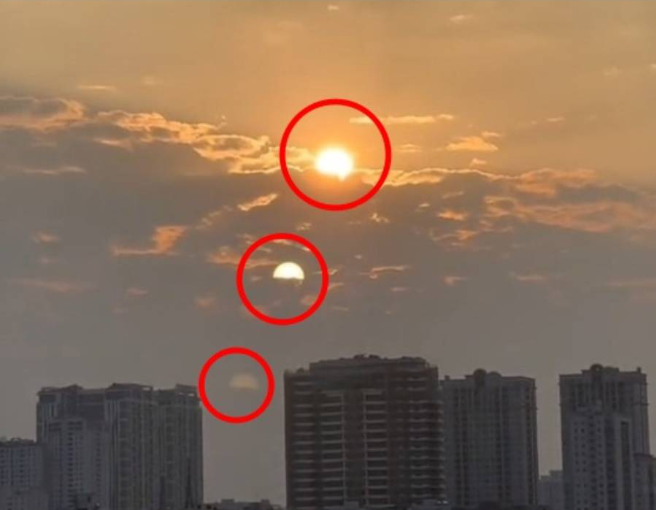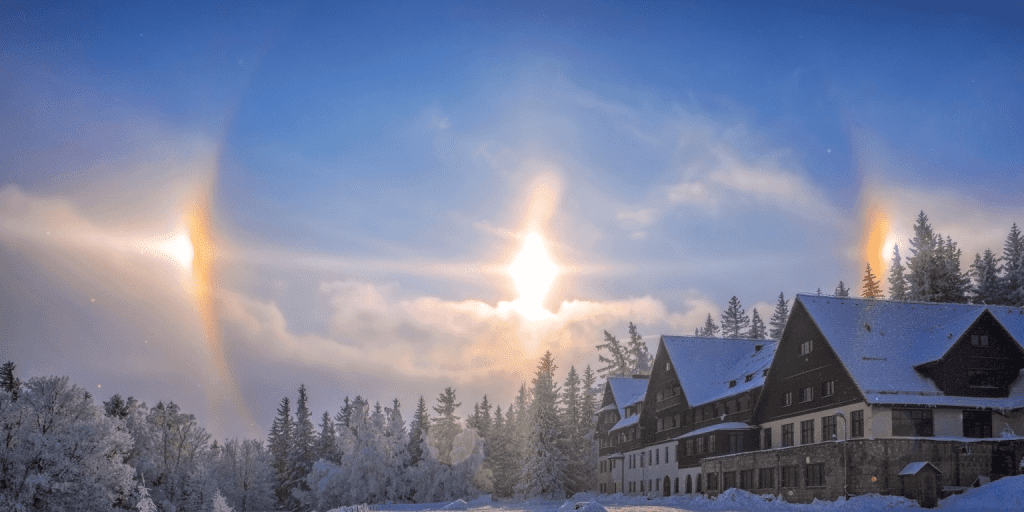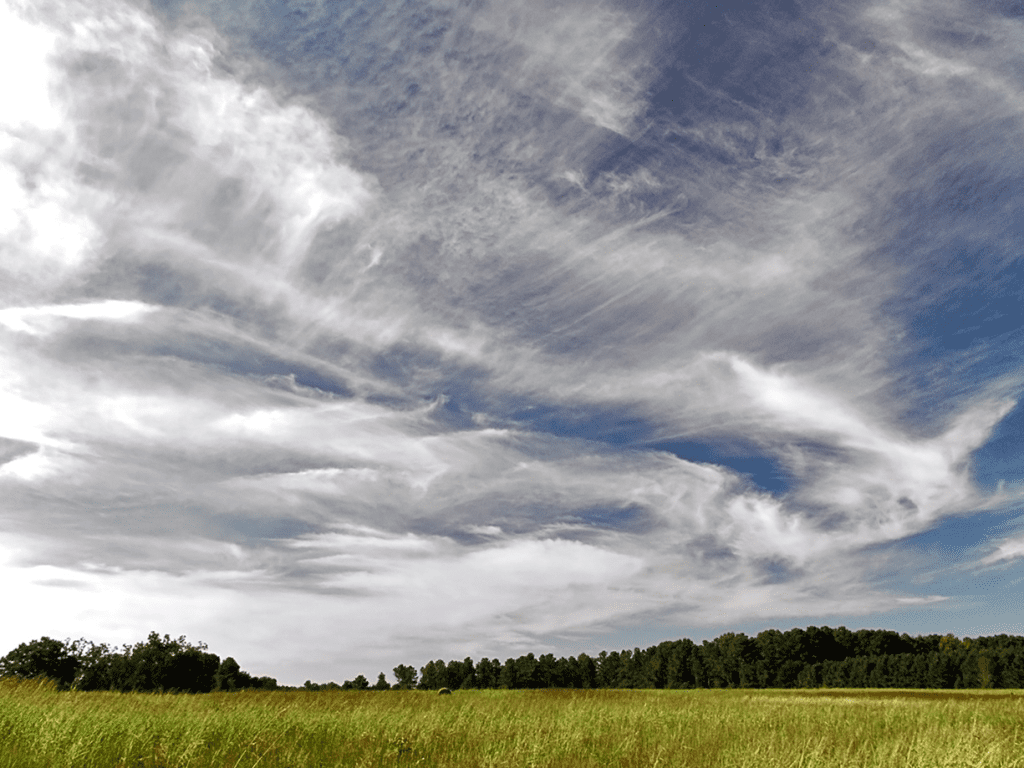Have you ever looked up at the sky and noticed not one, but three suns glowing at once? While it might sound like something out of science fiction, this strange phenomenon is very real and has an explanation rooted in atmospheric science. Known as “parhelion” or “sundog,” this optical illusion can leave you mesmerized by its surreal beauty. In this article, we’ll explore what parhelion is, how it forms, and why it often appears under specific weather conditions.

What Is Parhelion? Understanding the “Fake Sun” Phenomenon
Parhelion, commonly referred to as a “sundog,” is an optical phenomenon that causes the appearance of one or more bright spots around the sun. These spots can resemble additional suns, creating the illusion of two or three suns in the sky.
- The Basics: The term “parhelion” comes from the Greek words “para” (beside) and “helios” (sun), which together mean “beside the sun.” Parhelia typically appear as bright, rainbow-like spots to the left and right of the sun, often forming a halo-like arc.
- Optical Illusion: While parhelia may look like multiple suns, they are merely reflections or refractions of sunlight. These reflections occur when light passes through ice crystals in the atmosphere, causing a visual trick that makes it seem like there are extra suns.
How Does Parhelion Form? The Science Behind the “Three Suns”
The parhelion phenomenon occurs due to the unique interaction between sunlight and ice crystals in the upper atmosphere. Here’s how it works:
- Ice Crystals in the Air: Parhelia are formed when there are numerous ice crystals suspended in the atmosphere. These ice crystals are usually hexagonal in shape and are found in high-altitude cirrus clouds.
- Refraction of Light: As sunlight passes through these ice crystals, it gets refracted, or bent, at specific angles (usually around 22 degrees). This bending causes the light to disperse and form a bright spot beside the sun, resulting in the sundog effect.
- Environmental Conditions: For parhelion to be visible, the air must be cold and filled with moisture, leading to the formation of ice crystals. This is why sundogs are more common in colder regions or during winter months when ice crystals are more abundant in the atmosphere.
The Role of Cirrus Clouds: The Perfect Canvas for Parhelion
Cirrus clouds play a critical role in the formation of parhelion. These thin, wispy clouds are made up of tiny ice crystals, making them ideal for creating optical phenomena like sundogs.
- Characteristics of Cirrus Clouds: Cirrus clouds are high-altitude clouds, often found at elevations of 20,000 feet or more. They appear thin and feathery, resembling strands of silk or cotton, and are usually spread across the sky.
- Prism Effect: The ice crystals within cirrus clouds act like small prisms. As sunlight hits these prisms, the light gets bent and redirected, creating bright, colorful spots that mimic the sun’s glow. The result is the illusion of multiple suns in the sky.
- Viewing Conditions: Parhelion is best seen when cirrus clouds are relatively thick and positioned near the sun. The phenomenon is also more visible when the sun is lower on the horizon, typically during sunrise or sunset.
Why Are There Three Suns? Breaking Down the Illusion
The appearance of three suns in the sky is due to the arrangement and density of ice crystals, as well as the angle at which sunlight strikes them.

- The Real Sun vs. Sundogs: The brightest and central “sun” in the sky is the actual sun, while the two additional spots are sundogs created by the refraction of light. These sundogs are typically located on either side of the sun, at the same altitude, and are often accompanied by a faint halo.
- Symmetry and Alignment: The two sundogs are usually equidistant from the sun, forming a symmetrical pattern. This symmetry is due to the consistent shape and orientation of the ice crystals that cause the light to bend uniformly on both sides.
When and Where Can You See Parhelion?
While parhelion can occur anywhere in the world, it is more commonly observed in colder climates and during specific times of the day.
- Best Viewing Conditions: Sundogs are most frequently seen in the early morning or late afternoon when the sun is lower in the sky. This lower angle enhances the refraction effect, making the sundogs more pronounced.
- Ideal Locations: You are more likely to witness parhelion in regions with icy or snowy conditions, such as the Arctic, Antarctic, and northern parts of Europe, Asia, and North America. However, it can also be seen in other locations during cold winter days when cirrus clouds are present.
The Cultural Significance of Parhelion: Myths and Legends
Throughout history, the parhelion phenomenon has been the subject of myths, legends, and interpretations that go beyond its scientific explanation.
- An Omen of Change: In many cultures, sundogs were believed to be omens of change or significant events. For example, ancient warriors viewed the appearance of three suns as a sign of impending victory or defeat in battle.
- Symbol of Spirituality: In some indigenous cultures, parhelion is seen as a symbol of spiritual guidance, representing the presence of celestial beings or ancestral spirits.
- Awe and Wonder: Even today, the sight of three suns in the sky can inspire a sense of awe and wonder. It’s a reminder of nature’s ability to create beautiful, fleeting phenomena that seem almost otherworldly.

Why Does Parhelion Occur Only Sometimes?
The occurrence of parhelion is relatively rare, primarily due to the specific atmospheric conditions required for its formation.
- Limited Ice Crystals: For sundogs to appear, the atmosphere must contain the right amount of ice crystals at high altitudes. These conditions are more common in winter or in cold climates.
- Right Viewing Angle: The observer’s position also plays a crucial role. The sun, ice crystals, and observer must align correctly for parhelion to be visible. Even a slight change in the sun’s position can alter the phenomenon’s visibility.
- Brief Appearance: Sundogs typically last for a short period, making them even more challenging to spot. As the sun moves or the ice crystals disperse, the parhelion effect quickly fades.
Conclusion: Embracing the Beauty of Parhelion
Seeing three suns in the sky is a rare and mesmerizing experience that reminds us of nature’s optical wonders. Parhelion, with its breathtaking illusion of multiple suns, is not only a fascinating atmospheric phenomenon but also a testament to the complex interaction between light and ice in our atmosphere. So, if you ever find yourself witnessing this celestial spectacle, take a moment to appreciate the natural artistry at play—because you’re seeing one of the sky’s most unique and fleeting displays.


